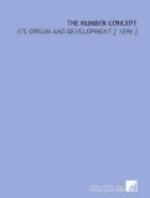The native languages of India, Thibet, and portions of the Indian archipelago furnish us with abundant instances of the formation of secondary numeral scales, which were used only for special purposes, and without in any way interfering with the use of the number words already in use. “Thus the scholars of India, ages ago, selected a set of words for a memoria technica, in order to record dates and numbers. These words they chose for reasons which are still in great measure evident; thus ‘moon’ or ‘earth’ expressed 1, there being but one of each; 2 might be called ‘eye,’ ‘wing,’ ‘arm,’ ‘jaw,’ as going in pairs; for 3 they said ‘Rama,’ ‘fire,’ or ‘quality,’ there being considered to be three Ramas, three kinds of fire, three qualities (guna); for 4 were used ‘veda,’ ‘age,’ or ‘ocean,’ there being four of each recognized; ‘season’ for 6, because they reckoned six seasons; ‘sage’ or ‘vowel,’ for 7, from the seven sages and the seven vowels; and so on with higher numbers, ‘sun’ for 12, because of his twelve annual denominations, or ‘zodiac’ from his twelve signs, and ‘nail’ for 20, a word incidentally bringing in finger notation. As Sanskrit is very rich in synonyms, and as even the numerals themselves might be used, it became very easy to draw up phrases or nonsense verses to record series of numbers by this system of artificial memory."[164]
More than enough has been said to show how baseless is the claim that all numeral words are derived, either directly or indirectly, from the names of fingers, hands, or feet. Connected with the origin of each number word there may be some metaphor, which cannot always be distinctly traced; and where the metaphor was born of the hand or of the foot, we inevitably associate it with the practice of finger counting. But races as fond of metaphor and of linguistic embellishment as are those of the East, or as are our American Indians even, might readily resort to some other source than that furnished by the members of the human body, when




